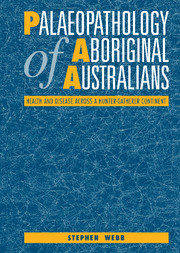Book contents
- Frontmatter
- Contents
- List of illustrations
- List of tables
- Acknowledgements
- 1 Introduction
- 2 Australian palaeopathology, survey methods, samples and ethnohistoric sources
- 3 Upper Pleistocene pathology of Sunda and Sahul: some possibilities
- 4 Pathology in late Pleistocene and early Holocene Australian hominids
- 5 Stress
- 6 Infectious disease
- 7 Osteoarthritis
- 8 Trauma
- 9 Neoplastic disease
- 10 Congenital malformations
- 11 Motupore: the palaeopathology of a prehistoric New Guinea island community
- 12 The old and the new: Australia's changing patterns of health
- References
- Index
2 - Australian palaeopathology, survey methods, samples and ethnohistoric sources
Published online by Cambridge University Press: 21 May 2010
- Frontmatter
- Contents
- List of illustrations
- List of tables
- Acknowledgements
- 1 Introduction
- 2 Australian palaeopathology, survey methods, samples and ethnohistoric sources
- 3 Upper Pleistocene pathology of Sunda and Sahul: some possibilities
- 4 Pathology in late Pleistocene and early Holocene Australian hominids
- 5 Stress
- 6 Infectious disease
- 7 Osteoarthritis
- 8 Trauma
- 9 Neoplastic disease
- 10 Congenital malformations
- 11 Motupore: the palaeopathology of a prehistoric New Guinea island community
- 12 The old and the new: Australia's changing patterns of health
- References
- Index
Summary
A brief history of Australian palaeopathological study
This chapter briefly outlines the few major papers that have discussed Australian palaeopathology. I will confine my remarks largely to those publications of substance and will not be referring to every remark made about a pathological bone from Australia, although I assure the reader that there are few of these.
The first palaeopathological survey of Aboriginal skeletal remains undertaken in Australia was made by Cecil Hackett (1933a,b,c, 1963, 1968, 1974, 1976). His data focussed on treponemal lesion morphology, particularly cranial vault lesions. He hoped that through analysis of a series of discrete and unique pathological changes in the appearance of these lesions he would be able to distinguish and document the differences between endemic forms of treponemal infection and those resulting from syphilis. The diagnostic criteria he established helped him achieve these ends so that the palaeoepidemiology of treponemal disease in Australia as well as its spread and distribution around the world could be understood more fully. Hackett extended his research to include a study of the tibial distortion known as ‘boomerang leg’ and I discuss this more fully in Chapter 6. His work in Australia, however, was part of a lifelong study of the treponematoses, particularly endemic forms, which he had pursued in many parts of the world, including Africa and the Middle East. He did not set out to document the status of Aboriginal health in the past, nor was his work considered strictly of a palaeopathological nature.
- Type
- Chapter
- Information
- Palaeopathology of Aboriginal AustraliansHealth and Disease across a Hunter-Gatherer Continent, pp. 5 - 20Publisher: Cambridge University PressPrint publication year: 1995



